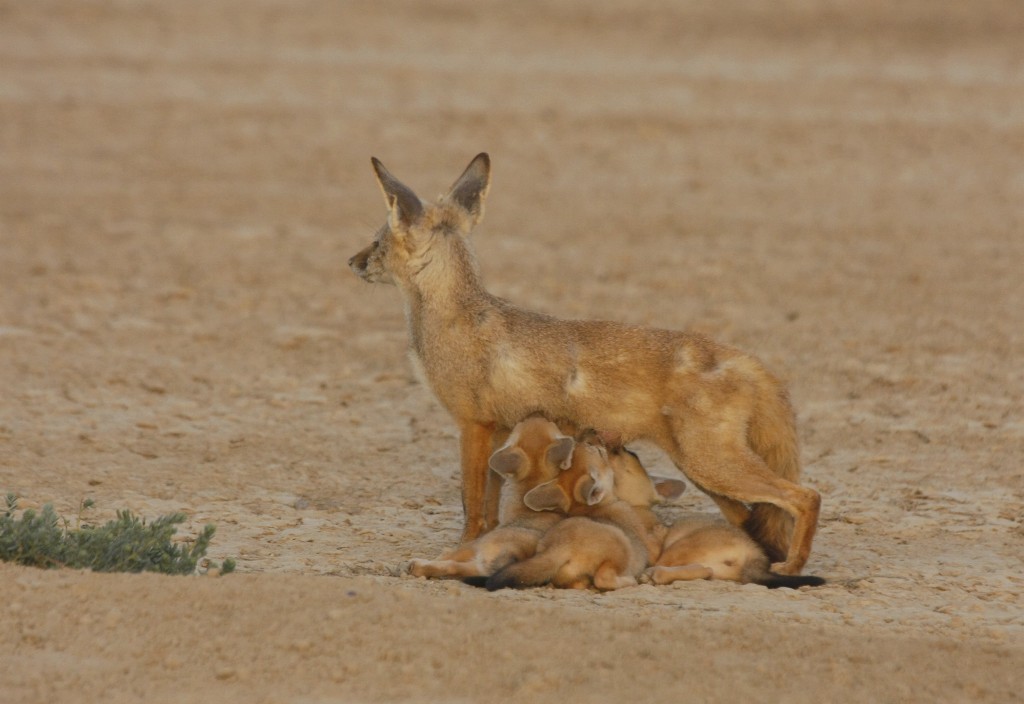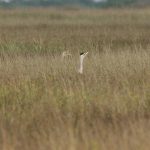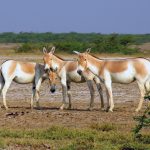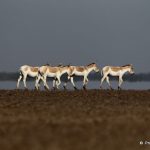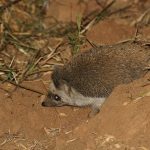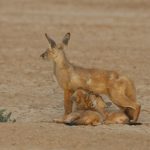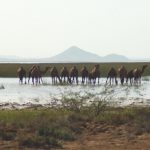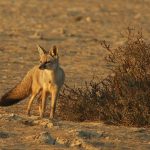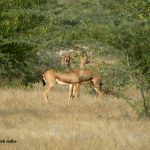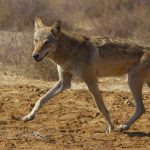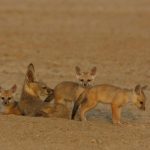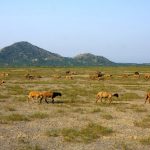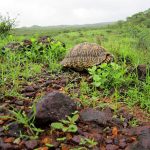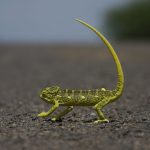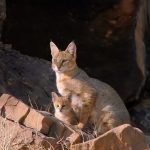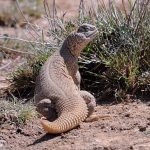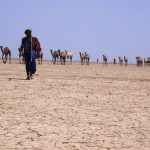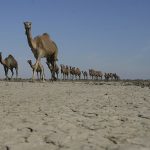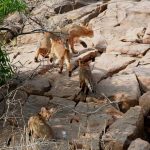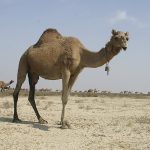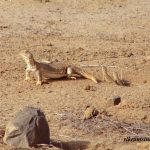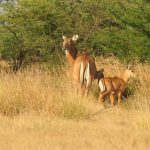Kutch Desert Wildlife
Kutch Desert Wildlife Sanctuary is the largest sanctuary of Gujarat. Kutch Desert Wildlife Sanctuary occupies an area of 7505.22 square kilometers. The Kutch Desert Wildlife Sanctuary of Gujarat comprises of forest area, revenue wasteland and territorial water of the Arabian Sea. Kutch Desert Wildlife Sanctuary lies in the north-eastern part of Kutch district that borders Pakistan and Wild Ass Sanctuary. Kutch Desert Wildlife Sanctuary was so declared in February 1986 and is the largest sanctuary of the country.
Kutch Desert Wildlife Sanctuary of Gujarat has vast area of sun-baked mud flats that are salt impregnated. Some of the area around Kutch Desert Wildlife Sanctuary in Gujarat have small patches of uplands and the hilly islands of the sanctuary are called bets. Kutch Desert Wildlife Sanctuary has marine calcareous grit and oyster bed in the shore bordering the Arabian sea.
Kutch Desert Wildlife Sanctuary in Gujarat houses some of the rare wild animals like striped hyena, porcupine, fox, small Indian civet, Indian pangolin and a large number of reptiles. You will find both venomous and non-venomous snakes, monitor lizards, star tortoise in the Kutch Desert Wildlife Sanctuary at Gujarat. Some of the rare species of birds are found in the Kutch Desert Wildlife Sanctuary at Gujarat.
Great Rann Of Kutch- Wild Ass Sanctuary
The Great Rann of Kutch is famous for its unique salt-pans where salt is harvested by local tribes. India was the largest salt producer in the world in the past and hamlet of Kharagodha in the Great Rann was then the very hub of the salt industry in India. It is said that Mahmud Beghada, the grandson of Sultan Ahmedshah who was the founder of the Ahmed Shahi dynasty had camped here with a force of 24,000 men in 1473. There was an acute shortage of water and on digging shallow pits they got brackish water which was not salty but bitter. This water proved to be most beneficial, since it contained high levels of magnesia and it was known to have cured acidity problems of the King. And therefore he named the place Kharagodha which in archaic Gujarati means – salty pits.
The revenue from salt had become the biggest source of income for the East India Company. It was more than the revenue collected from tea, opium, indigo or any other produce of India. Mahatma Gandhi was opposed to this tax and in his words “there is no article like salt outside water by taxing which the State can reach even the starving millions, the sick, the maimed and the utterly helpless. The tax constitutes therefore the most inhuman poll tax that ingenuity of man can devise”. He therefore decided to make salt tax as an issue to launch the freedom movement known as the famous march for salt or Dandi Yatra.
Apart from being a very important wetland for rare migratory birds, this area abounds in a variety of wildlife, most important species being the Asiatic wild ass. This is the last habitat in the world for this endangered species. Besides the wild ass, there are other endangered migratory species, like the hubara or Macqueen’s bustard, desert fox, desert wolf, chinkara gazelle and a host of other shore birds. Considering this fact, the Great Rann of Kutch or Wild Ass Sanctuary became notified in 1973 under section 18 of the Wild Life Protection Act as a Notified Wilderness Area covering 4954 sq. kms. The Great Rann of Kutch, with its unique salt-encrusted desert plains is the only sanctuary for the Asiatic Wild Ass in India. The sanctuary covers around 5,000 sq.km in the Great Rann of Kutch.
The wild animals that harbors in the Kutch Desert Wildlife Sanctuary include:
- Hyenas
- Jackals
- Birds
- Nilgai
- Chinkara
- Sambhar
- Wild Boar
- Indian Hare
- Pale Hedgehog
- Small Indian Civet
- Indian Porcupine
- Indian Fox
- Jackal
Great Rann Of Kutch- Flamingo Sanctuary
More than 200 bird species live in these seasonal salt marshes. Three of these species are threatened: the lesser florican, Houbara bustard, and Dalmatian pelican. During the wet season, the marshes become pink with flamingos. This area is the home of the largest flamingo breeding colony in the world. Millions of these tall, pink birds fly here each year to nest and raise their young.
During the rainy season, you`d see a rich array of wildlife especially the pink flamingos which flock to acres of salt marsh flowering plants. Flamingos build clay nests that rise above the water. There, both parents tend the eggs. Flamingos feed while standing in shallow water. They lower their necks and tilt their heads so that their bills hang upside-down and face backward in the water. In this way they filter plankton, red and blue-green algae, insects, fish, mollusks, and small crustaceans from the water. This diet, mostly the red and blue-green algae and insects which are high in alpha and beta carotenoid pigments, is what causes the flamingo`s striking pink color.
Three-fourths of this eco-region is protected. Cattle grazing, cutting trees for fuel and commercial mining of salt all pose threats to the eco-region even those areas that are protected. People also drive across the mudflats, and their vehicles damage the fragile ecosystem. Hunting of Asiatic wild asses is also still prevalent.
The avian species of the Kutch Desert Wildlife Sanctuary include the following:
- Stork
- Crow
- Spoonbill
- Sparrow
- Osprey
- White backed vulture
- Black vultures and more.
Great Rann Of Kutch- Salt Pans
The Great Rann of Kutch is very famous for its unique salt-pans where salt is harvested by local tribes. Salt in India was the biggest source of revenue for centuries. The production of sea salt was not a major activity in India earlier as the technique of deriving salt from sea water had not developed in India as the sea water had less density of only 4.5 Be. Rann starts with an initial density of 14 Be in winter and goes up to 18 Be in summer. It was this inland salt that brought in revenue. India was the largest salt producer in the world in the past and Kharagodha was then the very hub of the salt industry in India.
The revenue from salt had become the biggest source of income for the East India Company. It was more than the revenue collected from tea, opium, indigo or any other produce of India. Mahatma Gandhi was opposed to this tax and in his words “there is no article like salt outside water by taxing which the State can reach even the starving millions, the sick, the maimed and the utterly helpless. The tax constitutes therefore the most inhuman poll tax that ingenuity of man can devise”. He therefore decided to make salt tax as an issue to launch the freedom movement known as the famous march for salt or Dandi Yatra.
But the scenario has reversed today. The famous Baragara salt is no longer considered good for consumption, since, it cannot beiodized. The end of salt production in this region is not very far.

